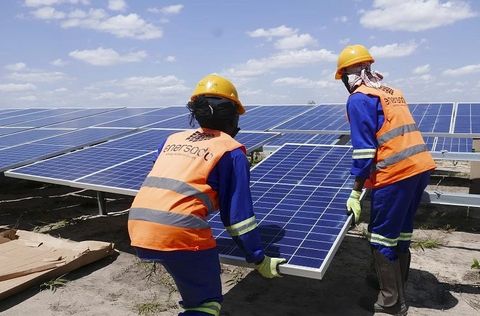Communication - Presse
Electricity production from solar parks in Mozambique grew by almost 20% in 2024

Electricity production from solar parks in Mozambique grew by 18.6% in 2024, but still represents less than 1% of total production, according to official data consulted by Lusa today.
According to the budget execution report with data from January to December 2024, electricity production from five large solar parks in the country, and from other smaller plants, exceeded 101,247 MegaWatt-hours (MWh) in this period, compared to 85,343 MWh in the whole of 2023.
For last year, the government had set the target of producing 138,808 MWh through the solar parks already in operation in the country, a target that was not achieved.
Despite the growth in production, solar parks accounted for only 0.5% of Mozambique’s total production in 12 months, led in 2024 by hydroelectric plants, with 83.8%, and essentially the Cahora-Bassa Hydroelectric Plant (81.7% of total electricity production up to December).
Mozambique plans to have solar power plants in at least five parts of the country by 2030, estimating that it will introduce 1,000 MW of electricity production capacity into the grid, promising a “true solar revolution”.
“Accelerating this type of project to a larger scale is the simplest way to resolve Mozambique’s strategic dilemma after 2030: having to choose between green energy for export or supplying energy to industrial consumers,” according to the Energy Transition Strategy (ETS), a document cited by Lusa in 2024.
Mozambique previously had projects for 125 MW of solar power plants, with 80 MW already connected to the grid.
The new strategy, which identifies investments of around US$80 billion (€76.5 billion) by 2050, foresees that Mozambique will develop, in a first phase, by 2030, “at least” 1,000 MW of new solar photovoltaic capacity in Dondo, Lichinga, Manje, Cuamba, Zitundo and other locations “to be identified”, and 200 to 500 MW of new onshore wind power capacity, namely in Lagoa Pathi, Inhambane. “Large industrial investors who require large quantities of green electricity should be
encouraged, through a favourable business and regulatory environment, to develop large-
scale solar and wind power projects,” the document adds. By 2050, the objective is to have at least 7.5 GW of solar photovoltaic capacity installed in Mozambique and up to 2.5 GW of wind power capacity.
“To ensure price optimisation and accelerate the expansion of solar and wind capacity, the Government should build on the Mozambique Renewable Energy Auction Programme,” the principles of which introduced “competition in the awarding of renewable energy contracts”, the document states.
“The rapid growth of solar expansion in South Africa following the introduction of auctions is a regional example to follow,” highlights the ETS, which also spotlights “long-term” initiatives.
“Continue to gradually develop the latest solar and wind generation potential to meet the growing demand for electricity. A true ‘solar revolution’ will be needed to meet Mozambique’s growing consumption in a clean way,” the ETS stresses.